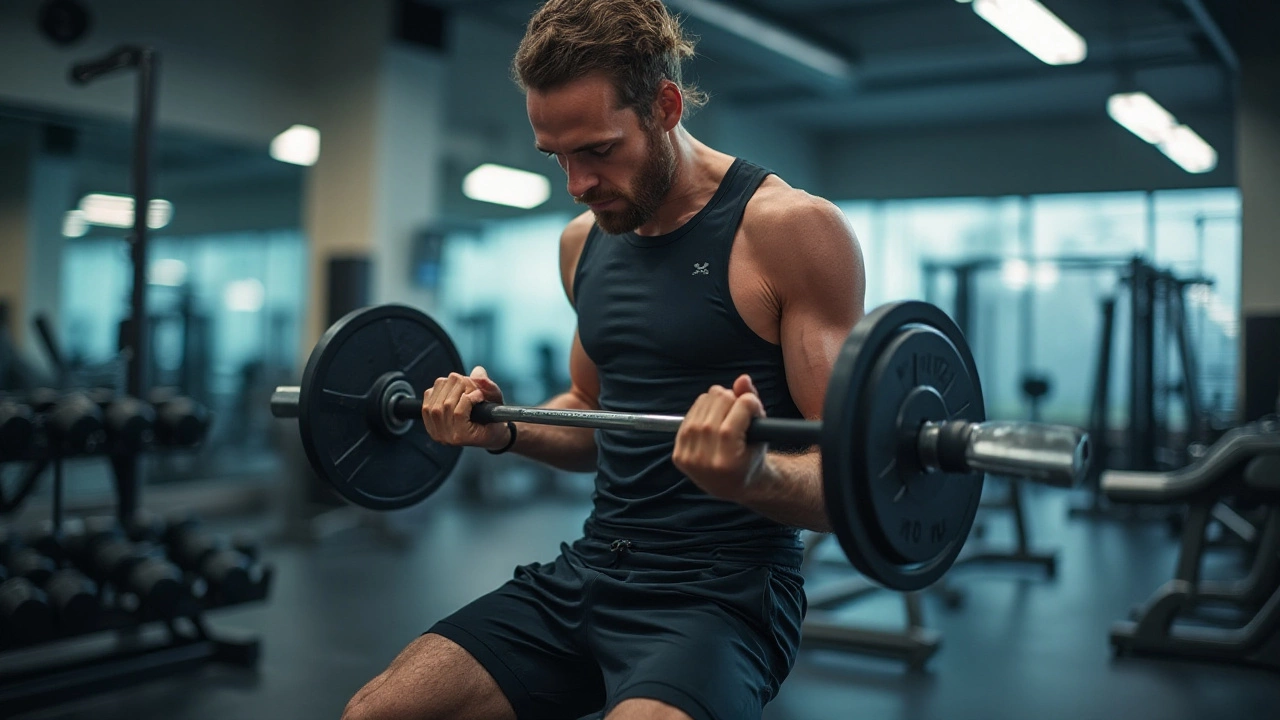Understanding What Qualifies as Sportswear in 2025

- Cleo Fairchild
- 12 January 2025
- 0 Comments
Sportswear has transitioned significantly over the years, taking on roles beyond mere function. Today's athletic clothing stands at the intersection of performance and fashion, providing individuals with a wide range of options that suit their active lifestyles.
Far from the simple cotton tees of the past, modern sportswear incorporates cutting-edge technology and innovative designs that cater to user comfort, durability, and utility in sports. But what exactly counts as sportswear in today's world, and how do you navigate the myriad options available?
This article examines the threads of the sportswear revolution, its essential characteristics, and how to make informed choices when picking out your next gym outfit or yoga ensemble.
- The Evolution of Sportswear
- Functional Features of Modern Sportswear
- The Importance of Fabric Choice
- Sportswear for Different Activities
- Tips for Selecting the Best Sportswear
The Evolution of Sportswear
The journey of sportswear is a fascinating tale woven into the fabric of human history, reflecting not only changing fashion trends but also our pursuit for performance and comfort in athletic endeavors. In the late 19th century, as organized sports began to gain popularity, the need for dedicated athletic clothing arose. At that time, sportswear was primarily designed with functionality in mind, often consisting of heavy wool materials that absorbed sweat but provided limited breathability.
As the 20th century dawned, the emergence of new materials like synthetic fibers transformed the landscape of athletic clothing. The introduction of nylon in the 1930s, followed by polyester in the 1950s, marked a significant shift toward lighter, more durable clothing that dried quickly, revolutionizing how athletes experienced their sports. The 1970s saw a fitness boom, fueling demand for more specialized gear, which in turn led to advancements in design and construction. This period also heralded the beginning of sportswear being worn beyond the field; brands began to explore the aesthetic potential of activewear, setting the stage for it to become a staple in everyday fashion.
The late 20th and early 21st centuries continued to push boundaries as lifestyle and sports began to intertwine. The rise of fitness apparel now focuses heavily on technology such as moisture-wicking materials, compression fits, and temperature regulation fabrics, catering to both professional athletes and casual fitness enthusiasts. The evolution of sportswear didn't just stop at functional features; it encompassed sustainable practices too. Today, many brands commit to eco-friendly manufacturing by using recycled materials, reducing water usage, and minimizing waste. According to a 2022 report, nearly 60% of sports brands had adopted at least one sustainable practice in their production process.
"Athleisure was more than just a trend; it represented a societal change in how we see comfort and function coexisting," observed Jane Bruton, editor of a leading fashion magazine.
Another remarkable shift is in the concept of inclusivity. Sportswear now recognizes the diversity of body types and the need for adaptive clothing options, ensuring everyone finds gear that fits comfortably and performs well. As technology progresses, we see innovations like smart fabrics that track biometric data, offering insights into one's performance and health. This constant evolution of activewear reflects how sportswear has become a significant part of our cultural identity, blurring the lines between formality and comfort while championing individuality. As we look ahead, the future promises even more personalized and intelligent sportswear solutions, shaping how we embrace our active lifestyles.
Functional Features of Modern Sportswear
Modern sportswear serves a dual purpose: helping athletes maintain peak performance while providing comfort and style. Today, technological advances have transformed athletic clothing, incorporating features that were once the stuff of sci-fi stories. Moisture-wicking fabrics, for example, are designed to pull moisture away from the skin, a key feature for keeping cool and dry during intense workouts. These fabrics help regulate body temperature, reduce skin irritation, and prevent the discomfort of a sweat-sodden garment. Many moisture-wicking materials are polyester or specialized fabrics like Dri-FIT and Climalite.
Breathability is another important aspect of sportswear. Mesh panels or strategically placed vents allow air circulation, providing added relief during high-intensity activities. This feature is crucial in reducing overheating and maintaining endurance levels. Compression wear, such as fitted leggings and tees, not only supports muscles to reduce fatigue but also promotes improved blood flow and quicker recovery times. Athletes have noted reduced muscle oscillation and micro-tearing, thanks to this ingenious invention. According to a study published in the Journal of Sports Sciences, compression clothing can also enhance proprioception, which is the awareness of the body's position and movement.
Beyond the essentials of breathability and moisture management, modern sportswear includes technologies like UV protection, which shields skin from the sun's harmful rays. Antimicrobial treatments help fight off odors by inhibiting the growth of bacteria, something that can make a world of difference for anyone who's spent hours training on hot summer days. Select brands also integrate smart technology into their apparel. Fitness enthusiasts can connect their garments to apps, measuring heart rate, steps taken, or calories burned seamlessly. A fascinating example is the Athos brand, which features sensors directly woven into fabrics to track muscle activity, giving athletes precise data to optimize their training routine.
"Performance clothes are getting smarter," The New York Times reported, "with embedded technology that gathers information about you in real-time."
Another consideration unique to modern sportswear is fashion. Once upon a time, athletic gear meant dull colors and basic designs, yet things have changed. Brands now offer vibrant hues and trendy patterns, often inspired by seasonal fashion shows. While aesthetics can't improve performance, the confidence boost of feeling stylish is a definite benefit. Not to mention, versatility is becoming fundamental in sportswear design. Athleisure has blurred the lines between gym wear and daily clothing, with leggings and tops that move effortlessly from squat racks to casual brunches. This shift signifies a lifestyle evolution, with consumers seeking functionality that's also socially acceptable in wider settings.
Innovative Fabrics and Materials
Sportswear innovations continue with fabric technologies that are as fascinating as they are functional. Eucalyptus-derived Tencel, for instance, is not only sustainable but boasts excellent moisture absorption and softness, elevating comfort levels. On the other end of the spectrum, we have all-weather gear that incorporates Gore-Tex materials, which offer waterproof yet breathable properties. Runners can train in pouring rain, while hikers can traverse wet terrains without worry.
Reflective materials are added features on running jackets and cycling gear, enhancing visibility in low-light settings and thereby improving safety. Zippers, seams, and pockets— often taken for granted—have seen significant redesigns. Flatlock seams reduce chafing, hidden pockets provide secure storage for essentials, and zippers are fabricated with weatherproof coatings to resist water entry.
As sophisticated as these features seem, they're just the tip of the iceberg. Ideally, the best piece of activewear combines multiple functional features without sacrificing comfort. By keeping up with these advancements, athletes and fitness enthusiasts can make informed choices, enhancing their performance, protecting their bodies, and, perhaps most critical, enjoying their athletic endeavors to the fullest.

The Importance of Fabric Choice
When it comes to selecting the right sportswear, the choice of fabric plays a crucial role in determining your comfort and performance levels. In the ever-demanding world of athletics and fitness, where every detail can impact your experience, understanding the role of fabric is essential. High-performance fabrics are designed to support an array of activities, each with its own unique requirements and challenges. The fabric you choose can significantly affect how you feel during exercise, from staying cool on a hot day to keeping your muscles supported during intense movements.
Most modern athletic clothing embraces the use of synthetic fibers, renowned for their moisture-wicking properties. Materials such as polyester and nylon are engineered to pull perspiration away from the body, allowing it to evaporate quickly. This is vital for maintaining comfort and reducing the risk of chafing and irritation. Fitness apparel manufacturers often combine these synthetics with elastane fibers, adding stretch and flexibility that accommodate a range of motion essential for sports.
On the other hand, some prefer natural fibers, such as cotton, for their breathability and softness against the skin. However, cotton tends to absorb moisture, which can lead to discomfort during prolonged activity. This is where blended fabrics come into play, offering a balanced solution. Blends that combine natural and synthetic fibers attempt to capture the best qualities of each, providing both comfort and performance. According to a study by Sports Technologists, 68% of athletes reported enhanced performance when wearing moisture-wicking materials compared to traditional cotton attire.
"Clothing choice can significantly enhance athletic performance by regulating body temperature and moisture," says Dr. Emily Rowe, an Exercise Physiologist at the National Sports Institute.
Furthermore, environmental consciousness drives brands to explore sustainable options. Eco-friendly fabrics such as recycled polyester and organic cotton converge in the market, offering athletes ways to minimize their carbon footprint without compromising quality. The rise of such materials marks a step forward in the fitness apparel industry, reflecting a trend toward a more sustainable future.
It is equally important that individuals consider allergies or skin sensitivities when choosing their fabrics. Testing new materials before committing to them in your regular routine can prevent unwanted discomfort or reactions. Ensuring that your sportswear aligns with your personal needs and preferences can make all the difference during a workout. The dynamic relationship between fabric choice and utility underscores an essential element of today’s activewear, encouraging athletes not just to train harder but also to train smarter.
Sportswear for Different Activities
When it comes to active pursuits, choosing the right sportswear can make a significant difference not only in performance but also in comfort and safety. Each sportswear category is crafted with specific features that cater to the demands of different activities. For runners, the right attire is all about breathable fabrics and absorbent materials, often featuring technologies like moisture-wicking. This type of clothing pulls sweat away from the body, which helps in regulating body temperature and reduces chafing during long runs. High-quality running gear often includes reflective elements to ensure visibility during low-light conditions, a crucial factor for those early morning jogs or late-night runs.
Cyclists, on the other hand, have unique requirements where clothing like padded cycling shorts and lightweight jerseys come into play. These are designed to minimize wind resistance and provide comfort during long rides. The padding in cycling shorts help with cushioning on the saddle, making those longer rides much more comfortable. Additionally, materials used are typically durable and aerodynamic, reducing air drag while optimizing speed. The jerseys often have pockets in strategic places to allow easy access to essentials like energy bars, hydration, or tools while on the move.
"The right apparel for a sport can enhance performance by up to 25% while significantly lowering the risk of injuries," says Dr. Emily Rogers, a sports physiologist.
When we look at yoga or Pilates, the focus shifts to mobility and comfort. The best yoga activewear typically consists of form-fitting tops and bottoms made from stretchy fabric that allow for full range of motion without restriction. This kind of clothing should aid in the flexibility of movements, providing support, particularly around the core, while ensuring fabric does not hinder your practice. Breathability and softer textures are priorities so that practitioners remain comfortable during different poses, whether they're holding a challenging posture or transitioning swiftly.
Weightlifting attire is another niche within the broad sportswear category, requiring robust support and greater flexibility around the shoulders and legs. Here, compression garments have gained popularity due to their ability to support muscle groups, increase blood flow and decrease muscle soreness after a heavy lifting session. Compression shirts and shorts provide a snug fit that contours around the muscles, thereby offering an additional layer of protection to the athlete. This is why a growing number of gym-goers and professional lifters have embraced compression gear for both performance and recovery purposes.
Specialized Gear for Extreme Activities
Extreme sports like rock climbing or snowboarding bring about another layer of complication to the sportswear world. These activities often demand specialized clothing that offers protection against harsh environments while still ensuring flexibility and comfort. For climbers, harnesses must be paired with durable but flexible trousers and tops, often made from reinforced materials that withstand abrasions against tough rock surfaces. Snowboarders, in contrast, require insulated but breathable waterproof gear that can handle icy conditions while keeping the body dry.
| Sport | Key Apparel Features |
|---|---|
| Running | Breathable, moisture-wicking, reflective elements |
| Cycling | Aerodynamic, padded shorts, strategic pockets |
| Yoga | Stretchable, soft texture, support around core |
| Weightlifting | Compression, flexibility in shoulders and legs |
| Extreme Sports | Reinforced, waterproof, breathable |
Understanding the importance of the right sportswear for specific activities is as crucial as understanding the activity itself. Selecting the correct gear can be the difference between a safe, effective workout and a potentially harmful experience. It’s rewarding to take the time to know what your sport needs precisely, considering the latest trends and technologies, as they open up new possibilities, turning the exercising experience into a more pleasant aspect of a daily routine.

Tips for Selecting the Best Sportswear
Choosing the right sportswear is a crucial step for anyone aiming to enhance their performance and enjoyment in any athletic pursuit. Whether it's for an intense workout session, a casual jog in the park, or a yoga class, selecting the best sportswear ensures not only comfort but also optimizes your performance. One of the first aspects to consider is the fabric. In recent years, there's been a surge in moisture-wicking materials such as polyester blends that help in absorbing sweat and regulating body temperature. These fabrics are pivotal in preventing chafing and irritation, keeping you focused entirely on your activity rather than discomfort.
Meanwhile, the fit of your athletic clothing plays a significant role in determining your range of motion and freedom to exercise efficiently. A snug fit can be beneficial for activities requiring agility, like running or cycling, as it reduces fabric flapping, while slightly looser fits might be more desirable for sports like yoga, where unrestricted movement is key. Likewise, attention to seam placement is vital; flatlock seams can aid in reducing friction against your skin, which is particularly essential during sustained physical action.
Moreover, consider the activity you'll be engaging in when selecting your sportswear. Different activities demand varying features; for instance, compression garments are popular in reducing muscle fatigue during long runs or high-intensity workouts. This is due to the gentle circular pressure applied over muscles, reinforcing the proprioception and enhancing blood circulation. On the other hand, reflective detailing comes in handy for any nocturnal workouts or commutes, significantly improving your visibility in low-light conditions.
Making a sustainable choice is another factor growing in importance today. Modern consumers are increasingly conscious of their ecological footprint, which is why sportswear brands have started introducing lines that use recycled or organic materials. Opting for such products means supporting initiatives aimed at reducing environmental impact. Furthermore, the durability of your fitness apparel is something you shouldn't overlook; investing in high-quality gear often translates into long-term savings since it withstands the wear and tear of frequent use.
“The right sportswear can make all the difference between a successful workout and a frustrating one. You need gear that moves with you and keeps you comfortable,” explains Sarah Jane, a well-known fitness expert and author.
Finally, don't forget the importance of style. While functional aspects are paramount, wearing gear that makes you feel good can boost your motivation and uplift your mood. Many brands now offer lines that are not only efficient in their function but also meet varied aesthetic preferences, from bold patterns to monochrome elegance. Thus, by considering all these factors together, you can make an informed decision and choose sportswear that complements your athletic endeavors.


